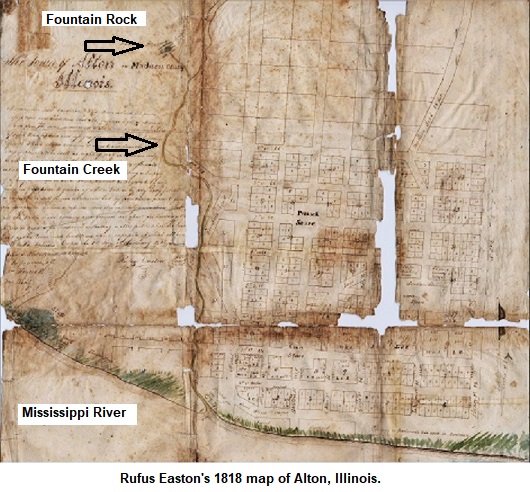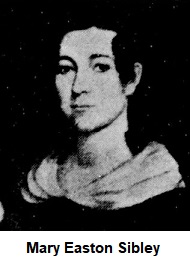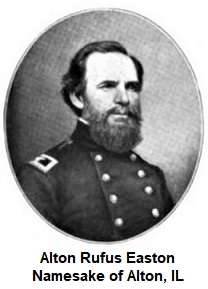Colonel Rufus Easton (1774-1834)
Founder of Alton
Early Life
Rufus Easton was born in Litchfield, Connecticut, May 04, 1774. He
was the
.jpg) son
of Joseph and Mahitable (Baker) Easton. Easton’s ancestors lived in
Connecticut since the year 1636. Rufus studied law at Westminster
College in New England, and moved to Rome, New York to establish a
law practice. He married Abial “Alby” Smith in 1799, and they had
the following children: Mary Easton Sibley (1800-1878); Johanna Alby
Easton Geyer (1801-1837); Louisa Baker Easton Gamble (1804-1879);
Alton Rufus Easton (1807-1893); Russella Easton Anderson
(1809-1840); Joseph George Easton (1812-1877); Colonel Langdon
Cheves Easton (1814-1884); Abial Alby Easton Watson (1818-1877);
Sarah Easton South (1820-1879); Medora S. Easton Bartlett
(1812-1895); and Henry Clay Easton (1826-1901).
son
of Joseph and Mahitable (Baker) Easton. Easton’s ancestors lived in
Connecticut since the year 1636. Rufus studied law at Westminster
College in New England, and moved to Rome, New York to establish a
law practice. He married Abial “Alby” Smith in 1799, and they had
the following children: Mary Easton Sibley (1800-1878); Johanna Alby
Easton Geyer (1801-1837); Louisa Baker Easton Gamble (1804-1879);
Alton Rufus Easton (1807-1893); Russella Easton Anderson
(1809-1840); Joseph George Easton (1812-1877); Colonel Langdon
Cheves Easton (1814-1884); Abial Alby Easton Watson (1818-1877);
Sarah Easton South (1820-1879); Medora S. Easton Bartlett
(1812-1895); and Henry Clay Easton (1826-1901).
In 1803, the Easton family settled briefly in Vincennes, Indiana
Territory. There he became friends with Edward Hempstead and John
Scott, joining them in William Henry Harrison’s expedition to set up
a territorial government in St. Louis, District of Louisiana, in
1804.
Federal Appointments
In 1805, a year after arriving in St. Louis, Easton received two
federal appointments from President Thomas Jefferson – Territorial
Judge and the first postmaster of St. Louis. Easton exchanged
correspondence with Aaron Burr during this time period regarding the
actions of James Wilkinson, an American soldier and statesman. Burr,
who had help arrange Easton’s appointment as Judge, visited St.
Louis in July 1805, and met with Easton and revealed to him some
details of his plot of setting up his own “empire” in the territory,
with Burr at the head, asking Easton to join. Easton refused and
broke off all further contact with Burr. Shortly thereafter, Easton
wrote to President Jefferson, informing him of Burr’s plot. In
retaliation, Wilkinson, a key Burr conspirator, began a campaign to
have Easton removed from the court by leveling charges of misconduct
and fraud. Easton was acquitted, and even traveled to Washington
D.C. to meet with Jefferson. Regardless, the President removed
Easton from his judicial post in February 1806. Several months
later, however, Jefferson attempted to set things right by
appointing Easton as U.S. Attorney for the territory. Easton
considered challenging Aaron Burr to a duel, but his friend, U.S.
Postmaster General Gideon Granger, convinced him not to pursue the
matter. Burr was experienced in such affairs of honor, having killed
Alexander Hamilton in an 1804 duel.
Bank Commissioner and Director; Delegate
to Congress
Easton was the first Freemason of record in the Louisiana Territory.
He ran for a delegate position for the first territorial
legislature, but was defeated by Edward Hempstead. He then became a
commissioner of the Bank of St. Louis, and in 1818 took over as
director of the bank. However, the Panic of 1819 adversely affected
the bank, and it closed within the year. Easton was elected a
delegate to Congress in 1814, for a period of four years.
The Founding of Alton, Illinois
In 1815, Colonel Easton purchased the site of the future town of
Alton as an investment. In 1817, Easton laid out the town plat,
which he named Alton, in honor of his first son, Alton Rufus Easton.
Many of the streets in the original plat of Alton were named after
the Easton children. The original town plat extended from Market
Street on the west, to Henry Street on the east, and from the river
north to Ninth Street.
The first step which Colonel Easton took towards building up Alton
was the establishment of a ferry across the Mississippi River called
“Fountain Ferry.” The landing place was at the mouth of “Fountain
Creek,” which flowed to the Mississippi River where Piasa Street is now located. The origin
of the creek was originally called Fountain Rock (where a spring
flowed from a cave), located at the foot of Fourth of July Hill,
just west of Belle Street, near E. 16th Street. This location was
later called “Cave Springs,” then “Five Points.” Throughout the
years the name of Fountain Creek was changed to Piasa Creek,
probably after the Piasa Bird legend.
In 1818, Reverend Thomas Lippincott was employed by Colonel Easton
to draw a map of Alton, which had been laid out the previous year.
This map was to be used for exhibition in the East, in order to
promote the sale of lots in Alton. Lippincott stated he took great
pains to draw the map in a professional manner, to give
satisfaction. Colonel Easton suggested to Lippincott that he
establish a store at Alton or close vicinity. He brought Lippincott
to Alton, where there was a cabin near the corner of William Street
and Broadway, occupied by a man and his family who ran Fountain
Ferry. The home was modest and primitive. It was not in Alton,
however, that Lippincott decided to open a store – but in the small
settlement of Milton, further east near the Wood River.
Colonel Easton was not prosperous in the land speculation, and it
left him in financial straits for the remainder of his life.

Appointed Attorney General; Retirement
Upon the organization of the Missouri government in 1821 (when St.
Charles was the first Missouri State Capital), Easton was appointed
Missouri’s second Attorney General, and continued in this office
until 1826. He semi-retired to his home at 210 South Main Street in
St. Charles, Missouri. He did occasional legal work and managed his
land holdings.
Easton’s Children
Easton’s favorite child was Mary, his first born (1800). She had
inherited her father’s musical talent, and they were very close. She
married Major George C. Sibley, who served in the War of 1812, and
was Indian Agent stationed at

Johanna Alby Easton, the second child of Rufus Easton (born in
1801), married in 1817 to Pryor Quarles, a physician. They had two
children. Quarles died in 1821, and she remarried to Henry Sheffie
Geyer in 1831. They had one son.
Louisa Baker Easton was born in 1804 in Rome, New York. Little of
known of her life. She married Archibald Gamble, a noted lawyer and
politician. She died in 1879 at the age of 74.

Rosella Easton was born in 1809, and was the fifth child of Rufus
Easton. She married Thomas L. Anderson in 1832, and they had four
sons. She died in December 1840 at the age of 30 or 31.
Joseph George Easton was born in 1812 in St. Louis. Little is known
of his life. He died in Hannibal, Missouri, in March 1877, at the
age of 64.
Langdon Cheves Easton was born in 1814, and entered West Point in
1833, graduating in 1838. He served in the Sixth Infantry as First
Lieutenant, Captain, Quartermaster, Lieutenant Colonel, and
Brigadier General. He campaigned in the capture of Atlanta, Georgia,
and retired in 1881.
Albial “Alby” Easton, born in 1818, married James Stewart Watson.
They had at least three children. Little is known of her life. She
died in 1877 in St. Louis.
Henry Clay Easton was born in 1826, and died November 22, 1901 in
St. Charles, Missouri, at the age of 75. Little is known of his
life.
Sarah Easton married Samuel South.
Medora Easton married Abner Bartlett, member of an old St. Louis
family.
The Death of Rufus Easton
Rufus Easton became ill in 1834, and his daughter, Mary, and his
wife, Abigal Alby Easton, did everything possible for his comfort.
His death on July 05, 1834, was a great shock to everyone. He was
buried in the Lindenwood College Cemetery. Abigal Easton died on
February 21, 1849, and is buried next to her husband.